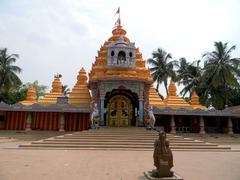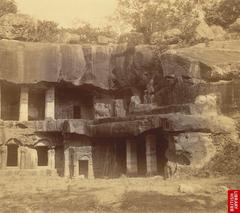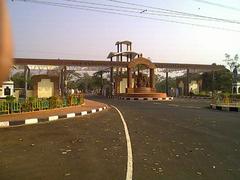Chandrasekhara Mahadeva Temple Bhubaneswar Visiting Hours, Tickets, and Travel Guide
Date: 04/07/2025
Introduction to Chandrasekhara Mahadeva Temple
The Chandrasekhara Mahadeva Temple stands as a profound emblem of Odisha’s rich religious and architectural heritage. Located in both Bhubaneswar and Dhenkanal, it draws countless devotees and visitors each year. Rooted in the Kalinga architectural tradition and dating back to the Keshari dynasty (9th–12th centuries CE), the temple is a testament to the region’s artistic and spiritual legacy. As a center of Shaivite worship, its sanctum houses the revered Siva lingam, symbolizing the cosmic union of Shiva and Shakti (AroundUs, Kevin Standage Photography).
The temple is more than a religious site—it serves as a vibrant cultural hub, hosting festivals such as Maha Shivaratri and Badaosa. Its strategic location within Bhubaneswar’s celebrated temple circuit allows visitors to embark on a spiritual and architectural journey alongside neighboring landmarks like Lingaraj, Mukteshwar, and Rajarani temples (TravelsnWrite, Trek Zone).
This guide offers a comprehensive overview of the temple’s history, architecture, religious significance, and practical visitor information, ensuring that travelers and devotees can plan an enriching experience at this treasured site.
Contents
- Historical Background
- Origins and Dynastic Patronage
- Architectural Features and Symbolism
- Evolution Through the Ages
- Community Role and Religious Significance
- Architectural Style and Layout
- Visiting Hours, Tickets, and Travel Information
- Special Events and Festivals
- Chandrasekhara Mahadeva Temple in Dhenkanal (Kapilash)
- Frequently Asked Questions (FAQs)
- Conclusion and Travel Tips
- Further Reading and Sources
Historical Background
Origins and Dynastic Patronage
The Chandrasekhara Mahadeva Temple in Patia, Bhubaneswar, traces its origins to the Keshari (Somavamsi) dynasty, which played a key role in shaping the city’s identity as the “Temple City of India.” The dynasty’s patronage led to the construction of hundreds of temples, with Chandrasekhara Mahadeva standing out for its ochrous sandstone structure and intricate Kalinga-style carvings (AroundUs, Kevin Standage Photography).
Architectural Features and Symbolism
Rising to 8.15 meters, the temple’s locally quarried sandstone walls are adorned with carvings of deities, mythological scenes, and intricate motifs. Its sanctum contains a Siva lingam set within a circular yoni pitha—symbolizing creation and cosmic balance (AroundUs). The authentic, unaltered stonework preserves the essence of the Kalinga architectural tradition.
Evolution Through the Ages
Despite surviving centuries of change, the temple retains its original grandeur. Its resilience mirrors the enduring spiritual culture of Odisha and underscores Bhubaneswar’s status as a living museum of sacred architecture (Kevin Standage Photography).
Community Role and Religious Significance
- Shaivite Worship: The Siva lingam makes the temple an active site for daily rituals and major festivals like Maha Shivaratri, attracting devotees year-round (AroundUs).
- Cultural Hub: The temple serves as a venue for festivals, cultural performances, and communal gatherings, supporting traditional arts and fostering a strong sense of community.
- Heritage Preservation: Managed by local trusts and community stakeholders, the temple’s maintenance highlights the collective effort to safeguard heritage and traditions (AroundUs).
- Integration in Temple Landscape: As part of Bhubaneswar’s renowned temple circuit, Chandrasekhara Mahadeva enhances the city’s spiritual and architectural landscape (TravelsnWrite).
Architectural Style and Layout
Kalinga Nagara Style
Chandrasekhara Mahadeva Temple exemplifies the Kalinga Nagara style, characterized by a curvilinear shikhara (spire), square sanctum (garbhagriha), and mandapas (assembly halls) aligned on an east-west axis. The temple’s vertical emphasis evokes the cosmic axis, connecting the earthly and the divine (The Design Gesture).
Construction Techniques
Built using dry masonry from locally sourced sandstone, the temple’s enduring stability and detailed ornamentation reflect the advanced craftsmanship of the era (The Design Gesture).
Ornamentation and Iconography
Elaborate carvings on the temple’s exterior depict deities, mythological tales, floral designs, and symbolic figures such as the divine feminine (Shakti). Subsidiary shrines and female figures, common in Bhubaneswar temples, further enrich the iconographic program (TravelTriangle).
Spatial Organization
The temple’s layout supports ritual movement: devotees enter from the east, circumambulate the sanctum, and participate in communal worship in the mandapas. The alignment and spatial organization follow ancient Vastu and Shilpa Shastra principles (The Design Gesture).
Comparative Context
Nearby temples like Lingaraj, Brahmeshwar, and Parashurameshvara offer points of comparison—each contributing to the evolution of the Kalinga architectural style in scale, ornamentation, and innovation (TravelTriangle).
Visiting Hours, Tickets, and Travel Information
Visiting Hours
- Daily: 6:00 AM – 8:00 PM (Patia, Bhubaneswar)
- Early mornings and evenings are optimal for spiritual ambiance and photography (AroundUs).
Entry Fees
- No entry fee; donations are welcome for temple upkeep.
Getting There
- By Air: Biju Patnaik International Airport, 6 km away.
- By Train: Bhubaneswar Railway Station, 12 km away.
- By Road: Well-connected by taxis, auto-rickshaws, city buses (Trek Zone).
Accessibility
- Courtyards and pathways are mostly accessible; uneven stone flooring may pose challenges for those with mobility issues.
Visitor Tips
- Dress modestly and remove footwear before entering the sanctum.
- Photography is permitted in outer areas but restricted inside the sanctum.
- Local guides enhance the experience with historical and cultural insights.
Nearby Attractions
- Lingaraj Temple: 2 km away, largest Kalinga-style temple.
- Brahmeshwar and Parashurameshvara Temples: Significant for their age and ornamentation.
- Mangala and Kalikadevi Temples: Nearby sacred sites enrich the pilgrimage circuit (Trek Zone).
Special Events and Festivals
- Maha Shivaratri: The most significant festival, marked by elaborate rituals, music, and dance.
- Badaosa and Sankranti: Important local celebrations that reinforce communal bonds (Temples of India).
During festivals, the temple is adorned with decorations and hosts special ceremonies, making it an ideal time for visitors seeking a vibrant cultural experience.
Chandrasekhara Mahadeva Temple in Dhenkanal (Kapilash)
Location and Accessibility
- Situated atop Kapilash Hill, 60 km from Bhubaneswar and 26 km from Dhenkanal Railway Station (Velpu).
- Access by climbing 1,352 steps or via the Barabanki motorable road.
Hours and Entry
- Open daily: 5:00 AM – 9:00 PM.
- Entry is free; donations appreciated.
Facilities
- Drinking water, restrooms, shaded rest areas, and parking are available.
- Prasadam offered to visitors; small shops sell offerings and snacks.
Best Time to Visit
- Winter months (September–February) for comfortable weather (Holidify).
- Avoid peak festival days for a quieter experience.
Dress Code & Etiquette
- Modest attire required; remove footwear before entry.
- Maintain silence and respect sanctity; photography may be restricted in certain areas.
Special Considerations
- The Barabanki road is suitable for elderly and differently-abled visitors; steps are more strenuous.
- Arrive early during festivals to avoid crowds.
Nearby Attractions
- Lord Vishwanath Temple (Budha Linga), Payamrta Kunda, Marichi Kunda, ancient monasteries, and the Udayagiri and Khandagiri caves (Velpu).
Frequently Asked Questions (FAQs)
Q: What are the visiting hours?
A: 6:00 AM – 8:00 PM in Bhubaneswar; 5:00 AM – 9:00 PM at Kapilash.
Q: Is there an entry fee?
A: No, entry is free at both locations.
Q: How do I reach the temple?
A: Accessible by air, rail, and road from Bhubaneswar and Dhenkanal.
Q: Are guided tours available?
A: Yes, local guides provide tours at both locations.
Q: When is the best time to visit?
A: Early mornings, late afternoons, and during winter months for pleasant weather.
Conclusion and Travel Tips
The Chandrasekhara Mahadeva Temple, whether in the urban heart of Patia, Bhubaneswar, or atop Kapilash Hill in Dhenkanal, is a remarkable blend of spiritual depth, cultural heritage, and architectural beauty. Its accessibility, inclusive atmosphere, and rich festival calendar make it a must-visit for devotees, history enthusiasts, and travelers alike. For the best experience, plan your visit during early morning hours or major festivals, dress respectfully, and consider hiring a local guide.
Download the Audiala app for self-guided audio tours and explore our related articles for more on Odisha’s temple heritage. Share your experiences on social media and contribute to the preservation of these sacred sites by practicing responsible tourism.
Sources and Further Reading
- AroundUs
- Kevin Standage Photography
- TravelsnWrite
- The Design Gesture
- TravelTriangle
- Wikipedia
- Temples of India
- Velpu
- Holidify
- Trek Zone
- Alalqab
- Stamped Moments
- Thrillophilia








